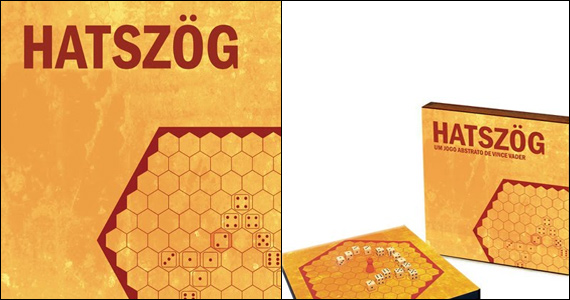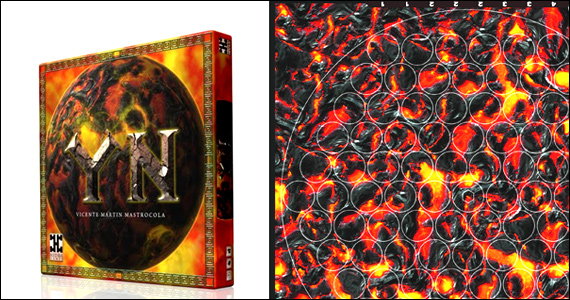By Vince
The game I'll use as an example in this post is YN (this is greek for "earth"). However, the game suffered a lot of changes from its creation until it was published. I want to show the different phases of this game design process.
Also, I would like to emphasize that this is just one way we can use to create games. I believe each game designer has his/her own techniques to create game ideas and gaming concepts.
•STAGE 1: write ideas, rough draft and pre-prototype them
First of all, I believe it is important to have a notebook to write your ideas. In this moment, use the force and let your mind flow, start to write every important thing. I use to call this process “single player brainstorm”.
While writing the ideas try to draw some rough drafts of the core idea of the game. It’s the first tests of mechanics and dynamics.
In the case of YN, I was thinking of an area control game with dices and dominos sequence mechanics. I’ve made a lot of studies and drawings to reach the balance of core mechanics, board layout, number of dices to each player and the most important: seeing if the game works
I think it's important – in this moment - to consider the idea that game design is the process of creating the content and rules of a game, and good game design is the process of creating goals that a player feels motivated to reach and rules that a player must follow as he makes meaningful decisions in pursuit of those goals. (BRATHWAITE & SCHREIBER, 2009)
So, in a few days I had a lot of rules notations and a pre-prototype board to start a beta test with some friends. In the picture below it’s possible to see the first model of the game (without an official name at this moment) made with paper, pen and a bunch of white dices.

•STAGE 2: prototype with simple layout
Well, if the pre-prototype works I think it’s fine to make a better version of the product. It’s time to make a real prototype in the computer using a minimum of layout just to give the game a clear aspect.
I always use Photoshop to create my prototypes. There’s a lot of tools in the software and it’s possible to make fast layouts in its interface.
In this part of the process I had an idea for the name of the game. I called it “Hatszög” (it means hexagon in Hungarian, I know it´s weird, but I am a hungarian language student) and I made a better board, bought good dices and even made a box with a simple illustration. And an important thing: in this moment the game had its rule book ready.
In the next picture it’s possible to see the prototype with a simple layout.

•STAGE 3: final and published version
So, we reach the third and final part of our game design process. A Brazilian company named HIDRA GAMES asked for an idea for a collection of abstracts games. This company already had a first game named AERO (with the idea of AIR element as the main theme) and was searching for a mechanics for the second game of the series: YN (with the EARTH theme).
So “Hatszög” turned into YN and a lot of things changed. In the mechanics we added a new element: a stone token that creates different setups on the board; so now it’s possible to put a sequence of dices from your pool and sometimes block the opponent’s strategy (and we made a lot of new beta testing sessions to adjust this new feature in the game). Just to remember and explain, the goal of the game is to place the biggest amount of dices as possible in the board, with the purpose to finish the game with the smaller sum of numbers on the remaining dices.
Well, the name has changed and the game gained a brilliant art from Marcelo Bissoli (a specialist in boardgame layout). He made a lot of changes like removing hexagons and putting circles in place. Marcelo also made a very beautiful volcanic background to the board and a spectacular box with a very vibrant and strong logo. Now we a have a finished game in all phases.
And the text behind YN’s box tells us: “Billions of years ago, when the earth was just an incandescent globe that began to cool - big masses of rocks and ores, that were before in a liquid state, started to solidify, creating what we call today a terrestrial crust. The magma, still boiling and liquid, started big waves around an unstable soil and this huge rock layers collided and rose from the soil, creating the mountains. In YN a player will experience the idea of creating these mountain rages using dices in a scenario that simulates the Earth at its formation process”.
Let´s see a little bit of the final layout of the game:

In a few words I think I transmitted the core idea of a game design process. I intend to show, in another post, the game design process to a narrative game, more specifically a mobile phone game where the player uses only SMS (short message service) to play. There are a lot of differences to show.
•REFERENCE:
BRATHWAITE, Brenda & SCHREIBER, Ian. CHALLENGES FOR GAME DESIGNERS: non-digital exercises for vídeo game designers. USA: Cengage, 2009.

Nenhum comentário:
Postar um comentário